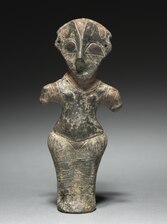Romanian art

Romanian art consists of the
Between the 5th and the 8th centuries, the process of
Historic overview
Prehistory
The present-day territory of Romania was inhabited by various cultures during Prehistory. The first objects featuring abstract geometric ornaments are from the Late Paleolithic and early Mesolithic, discovered in 1966 in the Iron Gates area, in settlements at Cuina Turcului, Schela Cladovei, Ostrovul Banatului etc. Usually these are household items with simple geometric incisions. A cave painting was discovered in the Cuciulat Cave (Sălaj County), probably dating from the Late Paleolithic.
During the Neolithic era, various cultures populated the current territory of Romania. Just like in the rest of Europe, the Neolithic starts in area of Romania in the 4th millennium BC. Scientists think that at the beginning of the Neolithic, migratory populations come here from West Asia, which will remain here and fuse with the locals from Mesolithic. Human communities make a transition to sedentary life. They left us pottery and abstract clay statuettes decorated with geometric patterns, that may give us hints on the way these civilizations used to dress and maybe tattoo. Just like art Palaeolithic art, Neolithic artworks are decorated with abstract geometric patterns, lines and spirals. Some of them may had religious or magical meanings. However, there's a big chance of these geometric ornaments having a purely decorative purpose, without any deep meaning.
The first Neolithic culture, known as the
The most famous Neolithic culture is Cucuteni–Trypillia. It produced many polychrome vessels in various shapes. All these vessels show the precision of the Neolithic people, since potter's wheel wasn't invented it, and so all these objects were produced manually. Just like any other culture of its time, it used geometric ornaments to decorate its artifacts, including sinuous lines, spirals, ovals combined with zigzags, and rhombi. The colours used for these vessels include white, red and/or chocolate black, used in various shades, since these they can be bicoloured or tricoloured.
Neolithic cultures are succeeded by the ones of
-
Cave painting, probably from the Late Paleolithic, pigment on stone, Cuciulat Cave, Sălaj County
-
The Sitting Woman, by the Hamangia culture, c. 5000 BC, terracotta, National Museum of Romanian History[8]
-
The Goddess from Vidra, by theGumelnița–Karanovo culture, c. 4700-3950 BC, ceramic, Bucharest Municipal Museum
-
Female figure, by the Vinča culture, c. 4500-3500 BC, fired clay with paint, Cleveland Museum of Art, Ohio, USA
-
Polychrome vessels (from left to right): a bowl on stand, a vessel on stand and an amphora, by the Cucuteni–Trypillia culture, c. 4300–4000 BC, fired clay with paint, Palace of Culture, Iași, Romania
-
Vessel, by the Boian culture, c. 4300–3500 BC, ceramic, Bucharest Municipal Museum
See also
- List of Romanian artists
- For information about Romanian literature, see: Romanian literature
- For information about Romanian history, see: History of Romania
- For other topics on Romanian culture, see: Romanian culture
Notes
- ISBN 978-606-33-1053-9.
- ISBN 978-606-33-1053-9.
- ISBN 978-606-33-1053-9.
- ISBN 978-606-33-1053-9.
- ISBN 978-973-1805-27-6.
- ISBN 978-606-33-1053-9.
- ISBN 978-0-7148-7502-6.
- ISBN 978-0-7148-7502-6.
References and further reading
- Vasile Florea: Arta Românească de la Origini până în Prezent ISBN 978-606-33-1053-9


![The Thinker, by the Hamangia culture, c. 5000 BC, terracotta, National Museum of Romanian History, Bucharest[7]](http://upload.wikimedia.org/wikipedia/commons/thumb/f/fa/Bucharest_-_The_Thinker_of_Cernavoda_-_white_bg.jpg/157px-Bucharest_-_The_Thinker_of_Cernavoda_-_white_bg.jpg)
![The Sitting Woman, by the Hamangia culture, c. 5000 BC, terracotta, National Museum of Romanian History[8]](http://upload.wikimedia.org/wikipedia/commons/thumb/e/e3/Bucharest_-_The_Sitting_Woman_of_Cernavoda_-_white_bg.jpg/157px-Bucharest_-_The_Sitting_Woman_of_Cernavoda_-_white_bg.jpg)



